Abstract
Background/aim
Respiratory muscle weakness and a low upper to lower chest diameter ratio are common respiratory dysfunction manifestations in children with cerebral palsy (CP), which negatively affect their quality of life. This study was conducted to investigate the effect of incentive spirometry (IS) training on these manifestations in those children.
Materials and methods
Totally, 30 children with spastic diplegic CP, aged between 6 and 12 years, were randomly assigned into two groups: the study group and the control group. Both groups received a traditional physical therapy program for 60 min. The study group received also IS training twice per session (15 min each). Children in both groups received 20 training sessions (five times/week for 4 weeks).
Outcomes
Respiratory muscle strength, ratio of upper to lower chest wall, gross motor function, and health-related quality of life were assessed before and after training.
Results
After training, significant improvements of maximal inspiratory pressure, maximal expiratory pressure, and ratio of upper to lower chest wall were obtained in the study group (P=0.002, 0.002, 0.005, respectively), whereas nonsignificant changes were obtained in the control group (P=0.719, 1, 0.284, respectively). In addition, a significant difference was observed between both groups in maximal inspiratory pressure, maximal expiratory pressure, but in favor of study group (P=0.001, 0.001, respectively), whereas there was a nonsignificant difference in the ratio of upper to lower chest wall, gross motor function, and health-related quality of life (P=0.279, 0.527, 0.876, respectively).
Conclusion
Feedback respiratory training improves respiratory muscle strength in spastic CP children.
Similar content being viewed by others
References
Msall ME. Developmental vulnerability and resilience in extremely preterm infants. JAMA 2004; 292:2399–2401.
Koman LA, Smith BP, Balkrishnan R. Spasticity associated with cerebral palsy in children. Pediatr Drug 2003; 5:11–23.
Abusamra R, Russell RR. Management of respiratory disease in children with muscular weakness. Paediat Child Health 2015; 25:515–521.
Ersöz M, Selcuk B, Gündüz R, Kurtaran A, Akyüz M. Decreased chest mobility in children with spastic cerebral palsy. Turk J Pediatr 2006; 48:344–350.
Gorter H, Holty L, Rameckers EE, Elvers HJ, Oostendorp RA. Changes in endurance and walking ability through functional physical training in children with cerebral palsy. Pediat Phys Ther 2009; 21:31–37.
Strauss D, Brooks J, Rosenbloom L, Shavelle R. Life expectancy in cerebral palsy: an update. Dev Med Child Neurol 2008; 50:487–493.
Fitzgerald DA, Follett J, Van Asperen PP. Assessing and managing lung disease and sleep disordered breathing in children with cerebral palsy. Paediatr Respir Rev 2009; 10:18–24.
Allen J. Pulmonary complications of neuromuscular disease: a respiratory mechanics perspective. Paediatr Respir Rev 2010; 11:18–23.
Wang HY, Chen CC, Hsiao SF. Relationships between respiratory muscle strength and daily living function in children with cerebral palsy. Res Dev Disabil 2012; 33:1176–1182.
Park ES, Park JH, Rha DW, Park CI, Park CW. Comparison of the ratio of upper to lower chest wall in children with spastic quadriplegic cerebral palsy and normally developed children. Yonsei Med J 2006; 47:237–242.
Bach JR, Bianchi C. Prevention of pectus excavatum for children with spinal muscular atrophy type 1. Am J Phys Med Rehabil 2003; 82:815–819.
Lissoni A, Aliverti A, Tzeng AC, Bach JR. Kinematic analysis of patients with spinal muscular atrophy during spontaneous breathing and mechanical ventilation1. Am J Phys Med Rehabil 1998; 77:188–192.
Lee HY, Cha YJ, Kim K. The effect of feedback respiratory training on pulmonary function of children with cerebral palsy: a randomized controlled preliminary report. Clin Rehabil 2014; 28:965–971.
Weindler J, Kiefer RT. The efficacy of postoperative incentive spirometry is influenced by the device-specific imposed work of breathing. Chest 2001; 119:1858–1864.
Spengler CM, Roos M, Laube SM, Boutellier U. Decreased exercise blood lactate concentrations after respiratory endurance training in humans. Eur J Appl Physiol Occup Physiol 1999; 79:299–305.
Sartori R, Barbi E, Poli F, Ronfani L, Marchetti F, Amaddeo A, et al. Respiratory training with a specific device in cystic fibrosis: a prospective study. J Cyst Fibros 2008; 7:313–319.
Kim K, Fell DW, Lee JH. Feedback respiratory training to enhance chest expansion and pulmonary function in chronic stroke: a double-blind, randomized controlled study. J Phys Ther Sci 2011; 23:75–79.
Choi JY, Rha DW, Park ES. Change in pulmonary function after incentive spirometer exercise in children with spastic cerebral palsy: a randomized controlled study. Yonsei Med J 2016; 57:769–775.
Palisano R, Cameron D, Rosenbaum P, Walter SD, Russel D. Stability of the gross motor function classification system. Dev Med Child Neurol 2006; 48: 424–428.
Ruppel G. Spirometry and related tests. In: Ruppel GL editor. Manual of pulmonary function testing, 8th ed. St. Louis: Mosby; 2003. pp. 72–74.
Wang HY, Yang YH. Evaluating the responsiveness of 2 versions of the gross motor function measure for children with cerebral palsy. Arch Phys Med Rehabil 2006; 87:51–56.
Russell DJ, Rosenbaum PL, Avery LM, Lane M. Gross motor function measure (GMFM-66 and GMFM-88) user’s manual. London, UK: Mac Keith Press 2002.
Varni JW, Seid M, Rode CA. The PedsQLTM: measurement model for the pediatric quality of life inventory. Med Care 1999; 37:126–139.
Restrepo RD, Wettstein R, Wittnebel L, Tracy M. Incentive spirometry: 2011. Respir Care 2011; 56:1600–1604.
Weiner P, Man A, Weiner M, Rabner M, Waizman J, Magadle R, et al. The effect of incentive spirometry and inspiratory muscle training on pulmonary function after lung resection. J Thorac Cardiovasc Surg 1997; 113: 552–557.
Overend TJ, Anderson CM, Lucy SD, Bhatia C, Jonsson BI, Timmermans C. The effect of incentive spirometry on postoperative pulmonary complications: a systematic review. Chest 2001; 120:971–978.
Ferreira GM, Haeffner MP, Barreto SSM, Dall’Ago P. Incentive spirometry with expiratory positive airway pressure brings benefits after myocardial revascularization. Arq Bras Cardiol 2010; 94:246–251.
So MW, Heo HM, San Koo B, Kim YG, Lee CK, Yoo B. Efficacy of incentive spirometer exercise on pulmonary functions of patients with ankylosing spondylitis stabilized by tumor necrosis factor inhibitor therapy. J Rheumatol 2012; 39:1854–1858.
Lee HY, Kim K. Can walking ability enhance the effectiveness of breathing exercise in children with spastic cerebral palsy?. J Phys Ther Sci 2014; 26:539–542.
Kwon YH, Lee HY. Differences of the truncal expansion and respiratory function between children with spastic diplegic and hemiplegic cerebral palsy. J Phys Ther Sci 2013; 25:1633–1635.
Litchke L, Lloyd L, Schmidt E, Russian C, Reardon R. Effects of concurrent respiratory resistance training on health-related quality of life in wheelchair rugby athletes: apilot study. Top Spinal Cord Inj Rehabil 2012; 18:264–272.
Author information
Authors and Affiliations
Corresponding author
Additional information
This is an open access article distributed under the terms of the Creative Commons Attribution-NonCommercial-ShareAlike 3.0 License, which allows others to remix, tweak, and build upon the work noncommercially, as long as the author is credited and the new creations are licensed under the identical terms.
Rights and permissions
About this article
Cite this article
El-Refaey, B.H., Abd-El Maksoud, G.M. & Ali, O.I. Efficacy of feedback respiratory training on respiratory muscle strength and quality of life in children with spastic cerebral palsy: Randomized controlled trial. Bull Fac Phys Ther 22, 46–52 (2017). https://doi.org/10.4103/bfpt.bfpt_65_16
Received:
Accepted:
Published:
Issue Date:
DOI: https://doi.org/10.4103/bfpt.bfpt_65_16




